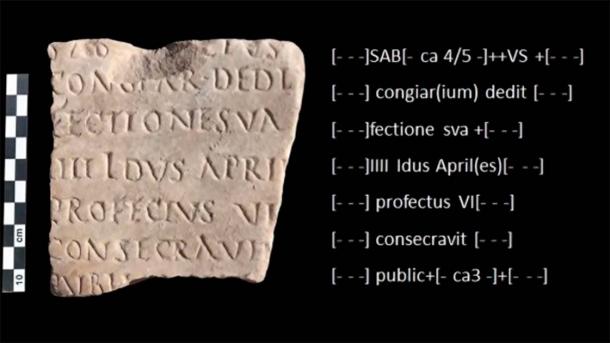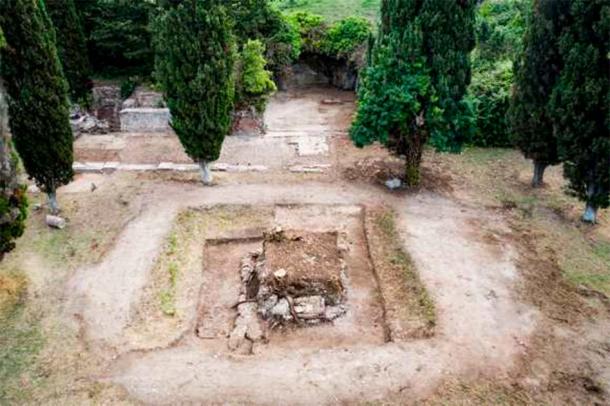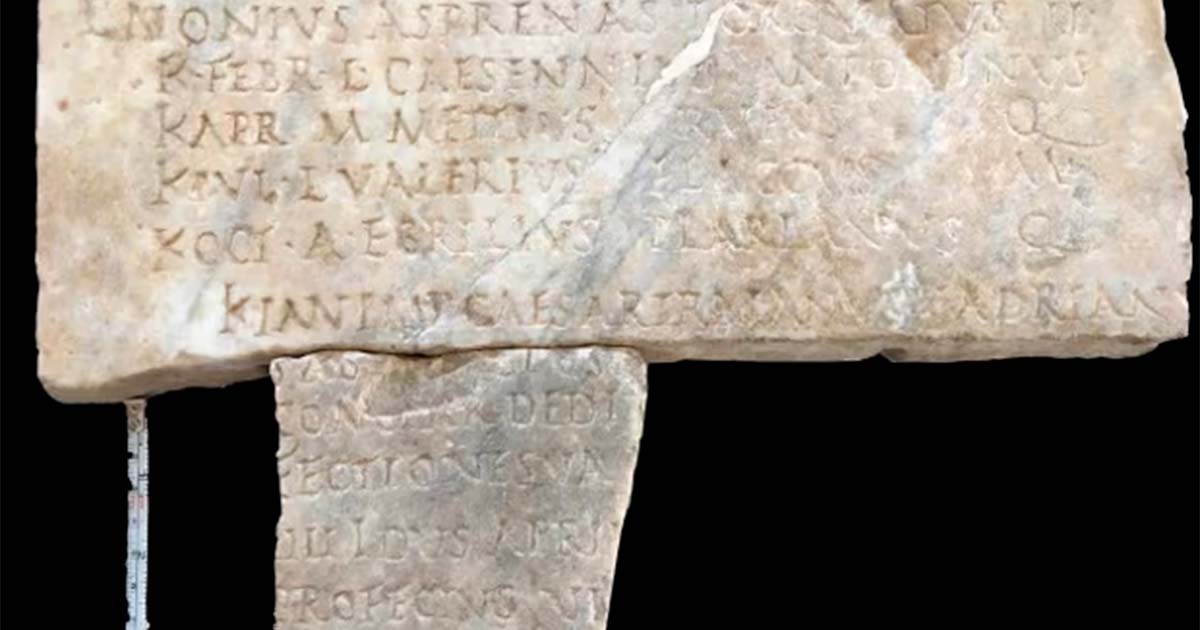Roman Chronicle Fragments Offer a New Glimpse of Emperor Hadrian’s Agenda
2,400 years ago, at the mouth of the Tiber River, the Romans established an armed camp and settlement known as Ostia Antica. Eventually transforming into “a flourishing commercial center”, it became a vital harbor and base for the Romans to expand from. Now the site of a rich archaeological park under excavation, two newly discovered fragments of inscribed marble slabs, a type of Roman chronicle that record ancient activities, known as ‘Fasti Ostienses’, have been uncovered, one of which is a perfect match for another discovered a few years ago!
Unlocking the Roman Chronicle: Fasti Ostienses and the Political Tapestry of Rome
These invaluable marble slabs provide a glimpse into the political and monumental history of both Rome and Ostia, spanning from 49 BC and possibly extending beyond 175 AD. The Fasti Ostienses are a rare type of ancient Roman calendar, chronicling the events involving emperors and other officials. They were meticulously drafted by the Volcani, the highest religious authority in the region, reports The Guardian. Among the treasures etched on these stone tablets, the daily calendar entries of Emperor Hadrian (reigned 117-138 AD) have emerged.
“This is an extraordinary discovery that, on the one hand, increases and complements what we know about the activity of the great emperor who was Hadrian by bringing new information on the very important building activity he conducted in Rome, on the other hand it reconfirms the immense potential of ancient Ostia for an ever deeper knowledge and popularization of our past,” said the director of the Archaeological Park of Ancient Ostia, Alessandro D’Alessio.
![Previously discovered fragment of the Fasti Ostienses that mentions Pharasmanes II of Iberia. PHARASMAN'[ES REX IBERORVM CVM FILIO] E ET VXORE PHR [CVI IMP (ERATOR) ANTONINVS AVG (VSTVS) REGNVM] REDDIDIT Translation: Pharasman [es, the king of Iberia with the son] and his wife Phr [to whom the emp[eror] Antoninus Aug[ustus], the kingdom] restored. (Public Domain)](https://www.ancient-origins.net/sites/default/files/Previously.jpg)
Previously discovered fragment of the Fasti Ostienses that mentions Pharasmanes II of Iberia. PHARASMAN'[ES REX IBERORVM CVM FILIO] E ET VXORE PHR [CVI IMP (ERATOR) ANTONINVS AVG (VSTVS) REGNVM] REDDIDIT Translation: Pharasman [es, the king of Iberia with the son] and his wife Phr [to whom the emp[eror] Antoninus Aug[ustus], the kingdom] restored. (Public Domain)
Hadrian’s Calendar
One of the newly unearthed fragments seamlessly aligns with a previously discovered section, as mentioned above, and dates to the year 128 AD, during Hadrian's rule. This inscription paints a vivid picture of that year's events, commencing with January 10th when Hadrian was bestowed the revered title of ‘ pater patriae’, or father of his country, while his wife Sabina was honored with the title of ‘Augusta’. To mark this momentous occasion, Hadrian made a generous gesture to the people by offering a ‘ congiar dedit’, a monetary gift, reports Arkeonews.

Detail of one of the fragments, which fits perfectly with another already preserved in Ostia, and referring to the Roman chronicle of the years 126-128 AD. It mentions facts and events that took place in Rome in 128, during the reign of Hadrian. (Italian Ministry of Culture)
As the year unfolded, on April 11th, 128 AD (as noted in the inscription: "ante diem III Idus April"), Emperor Hadrian embarked on a journey to Africa. Upon his return to Rome, between late July and early August, he conducted a consecration (‘ Consecravit’, as stated in the inscription) of a building within the city.
This structure is believed to be either the iconic Pantheon or, more plausibly, the Temple of Venus and Rome. Perhaps, this consecration might have taken place on August 11th, 128 AD, possibly to commemorate the 11th anniversary of Hadrian's ascension to the throne in 117 AD. These fragments were found in the forum of Porta Marina, a large rectangular building, where the Fasti Ostienses were carved into columns.
The initial findings of Fasti Ostienses fragments date back to 1940 and 1941, with subsequent discoveries occurring between 1969 and 1972. One of the recently discovered pieces and its connection to one of the earlier discovered pieces forms a cohesive and cogent narrative. This combined slab continuously chronicles the period of 126-128 AD. A selection of these historical calendar fragments, spanning the period from 49AD to 175AD, is now proudly showcased within the Vatican Museums.

Excavation was carried out at the archaeological site Ostia in Rome. (Italian Ministry of Culture)
Ostia and the Tremendous Archaeological Window into the Past
Situated less than 19 miles (30km) from Rome, Ostia Antica remained shrouded in ruins for centuries until the 19th century. This site boasts a well-preserved theatre, which serves as a modern-day venue for various performances and concerts. In addition, there are remnants of Roman baths, educational institutions, temples, and even a synagogue – a rich showcase of this once armed camp.
Legend has it that Ostia was founded in 620 BC by Ancus Marcius, the King of Rome, strategically positioned to harness the valuable salt pans located at the mouth of the Tiber River. However, the earliest archaeological evidence paints a different timeline, with remnants dating back to the latter part of the 4th century BC.
- Mythbusting Ancient Rome – Did All Roads Actually Lead There?
- The Precious Knowledge of the Hypatian Codex: Detailed Chronicle of the Southern Rus
“Even the latest excavation campaign just completed in the Archaeological Park of Ostia gives us treasures of inestimable value and very precious documentary sources to understand the activities of the great emperor Hadrian. The discovery of two fragments of the Fasti allows us to reveal important pieces of the life of Ostia and the capital. These excavations have also brought to light the remains of various decorations and extensive portions of the mosaic floor which will soon be visible to the public, just as has already been achieved in other archaeological sites in our nation thanks to the activity put in place in these months by the Ministry of Culture”, concluded the Minister of Culture, Gennaro Sangiuliano.
Top image: Two new fragments of Roman chronicle ‘Fasti Ostienses’ have been unearthed in the Ostia Antica Archaeological Park. Source: Italian Ministry of Culture
By Sahir Pandey
References
Altuntas, L. 2023. Two new fragments of the Fasti Ostienses, a kind of chronicle engraved on marble slabs, have been found in the Ostia Antica Archaeological Park. Available at: https://arkeonews.net/two-new-fragments-of-the-fasti-ostienses-a-kind-of-chronicle-engraved-on-marble-slabs-have-been-found-in-the-ostia-antica-archaeological-park/.
Giuffrida, A. 2023. Roman fragments offer glimpse of emperor Hadrian’s daily events calendar. Available at: https://www.theguardian.com/world/2023/aug/15/roman-fragments-emperor-hadrian-daily-events-calendar-ostia-antica-italy.
Ritter, M. 2023. Ancient marble piece is perfect match for artifact found years ago. What do they mean? Available at: https://www.miamiherald.com/news/nation-world/world/article278342149.html#storylink=cpy.

















